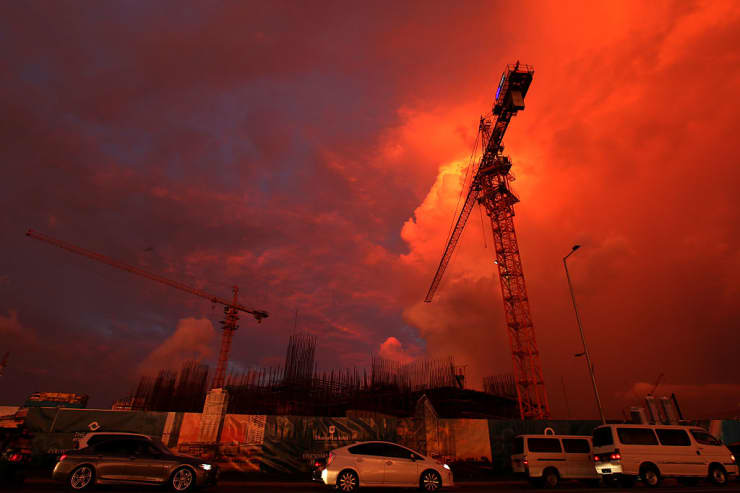
China’s lending to other countries, often shrouded in secrecy, is thought to be higher than the amounts that are officially tracked, resulting in much “hidden debt.” That growing debt problem could spark a worse-than-expected slowdown, among other problems, experts warn.
The lack of transparency would also affect investors who are considering bonds issued by those countries, or organizations such as the International Monetary Fund (IMF) which are helping those countries with their debts, according to Carmen Reinhart, a professor at the Kennedy School of Government at Harvard University.
Speaking at the Nomura Investment Forum in Singapore late last month, she said: “China’s rise as a global creditor has also meant that there are a lot of hidden debts. That is, countries that had borrowed from China but this borrowing is not reported by the IMF, by the World Bank. ”
“So there is a tendency to think these countries had lower debt levels than what they actually have,” she concluded.
That would hinder the IMF or the World Bank in doing their work on debt sustainability analysis, she said. That effort includes analyzing countries’ debt burdens, and coming up with recommendations for a borrowing strategy that limits the risk of debt distress.
“From the vantage point of surveillance, this means that the IMF, if they’re doing debt sustainability for example for Pakistan, unless they know how much Pakistan owes China, they are doing that sustainability exercise blindfolded, ” Reinhart said.
For investors, the limited information they have hinders them in making investment decisions about bonds issued by those countries if they don’t know how much is actually owed to China already, she added. That could lead to them underestimating the risk of lending money to those countries through bonds.
Reinhart told the conference that, since 2011, there had been many such loans those countries took from Chinese lenders which needed to be restructured, or renegotiated. Such nations include Sri Lanka, Ukraine, Venezuela, Ecuador, Bangladesh and Cuba, according to Reinhart.
Official debt statistics are tracked by the International Monetary Fund and the World Bank, but that only captures about half the Chinese loans to other countries, Reinhart estimated.
Furthermore, China is not a member of the so-called Paris Club, which also tracks official lending, and is “not interested” in joining, said Reinhart. The Paris Club is a group of creditor nations which aims to fix debt problems of other countries.
Those loans to countries have been shrouded in secrecy, according to reports, with China often demanding public-sector assets as collateral.
One example of those opaque loans is how Chinese loans to Venezuela were denominated in barrels of oil, according to a speech last year from David Malpass, the current president of the World Bank who was then the U.S. Treasury Undersecretary for International Affairs. “This has the effect of masking the exact amount of payments that China made to Venezuelan officials and that Venezuelans are expected to make to China in the future,” he said.
“If you ask China for its terms you will not find them,” he said in that speech.
Both the IMF and World Bank have called for more transparency on those loan amounts and terms in their annual Spring Meetings in April this year.
In response to a query from CNBC, the World Bank said that debt transparency is “critical.”
“Borrowers need comprehensive and timely debt data to make informed decisions. It also allows lenders to manage lending risks more efficiently — thereby bringing down the cost of lending for everyone,” it said.
Furthermore, the international organization said, debt transparency lets citizens “hold their governments accountable.”
“In short, debt transparency is essential for economic development. So when debts are ‘hidden,’ that’s a problem for everyone — not just the World Bank or the IMF. It’s especially a problem for the citizens of countries whose hidden debt is suddenly discovered, since uncertainty can lead to higher funding costs or, in the worst case, cut them off from funding,” the World Bank statement said.
That under-reported debt situation could be a problem, according to Kaho Yu, senior Asia analyst at Verisk Maplecroft.
“Although Beijing’s lending can help developing countries, an opaque build-up of debt may eventually drag down economic growth,” he told CNBC in an email.
Yu added: “China might have assured the developing countries that the cost of the loans would be covered by projects in the long run once they become operational, but no guarantee is given.”
China has been criticized for saddling many countries with debt through its Belt and Road Initiative — a mammoth infrastructure investment plan to build rail, road, sea and other routes stretching from China to Central Asia, Africa and Europe.
Chinese financial institutions have provided more than $440 billion in funding for Belt and Road projects, People’s Bank of China Governor Yi Gang said during a talk at the second Belt and Road Forum in Beijing early last month.
Much of the lending is done through two policy banks — the China Development Bank and Export-Import Bank of China. The Export-Import Bank of China had said in April that it has provided more than $149 billion in loans to more than 1,800 Belt and Road projects, while the China Development Bank said in March that it had provided financing in excess of $190 billion for more than 600 Belt and Road projects since 2013.
But Yu cautioned that the lack of transparency surrounding the loans meant that there is also uncertainty around how sustainable the projects are.
“There are uncertainties about the long-term viability of the projects supported by China’s under-reported loans due to the lack of transparency and accountability. Although there will be a surge in (foreign direct investments) in the early stage of the projects, the deficit will widen in the long run,” he told CNBC.
One high-profile example would be Sri Lanka, which had to hand over a strategic port to Beijing in 2017, after it couldn’t pay off its debt to Chinese companies.
It was seen as an example of how countries that owe money to Beijing could be forced to sign over national territory or make steep concessions if they can’t meet liabilities — a phenomenon dubbed debt-trap diplomacy. However, Chinese President Xi Jinping’s government has denied that the country is employing such a strategy.
The IMF declined to comment beyond referring CNBC to a speech Lagarde delivered in April. In that, she said “debt sustainability … will strengthen BRI sustainability,” but she did not appear to address the issue of hidden debt affecting her group’s ability to conduct analysis.
“History has taught us that, if not managed carefully, infrastructure investments can lead to a problematic increase in debt,” she said.
With risks increasing — whether associated with China’s slowing economy or the Belt and Road project — Chinese loans to other countries could slow going forward.
Tom Rafferty, principal economist for China at the Economist Intelligence Unit, pointed to more risks ahead and said the outlook for Chinese lending going forward would be “restrained.”
“Chinese overseas lending slowed quite strongly in 2018 as risk aversion grew and constraints began to emerge in terms of US dollar financing,” he told CNBC in an email, citing information in the annual reports of China’s two policy lenders —
Rafferty explained that China’s traditionally large current account surplus has been generating the foreign exchange reserves — held in U.S. dollars — that are used for its overseas lending, especially to countries involved in the Belt and Road projects.
But China’s current account is now shrinking, constraining its U.S. dollar financing.
[“source=cnbc”]




